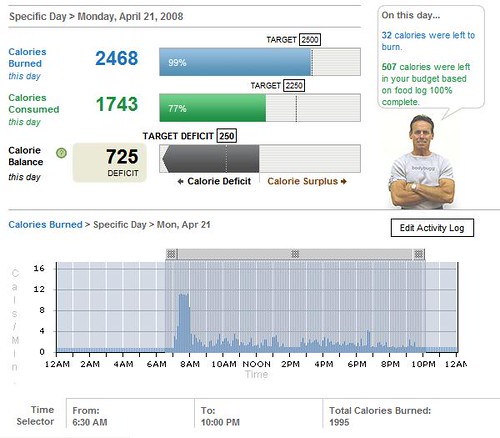The art of weight loss isn’t rocket science, however given the fact that weight loss is a multi-billion dollar industry, we can see that it eludes quite a number of folks. Weight maintenance/loss/gain is simply a matter of “calories in” versus “calories out”. On the nutrition side, if you eat more calories than your body needs, you’ll gain weight; if you eat the same number of calories that your body needs, then you will maintain your weight; and if you consume fewer calories than your body needs to maintain it’s weight, you will lose weight. But, how do you know how many calories your body needs to maintain it’s weight?
In But … how do you know? Part 1, I explained that our metabolism (BMR),depending on how active a person is, can make up for approximately 75% or less of our calories burned. I also explained how we can estimate our BMR. So, that gives us a starting point.
The thing is, the body is a very complex sophisticated organism. In order to lose weight, you want to take in fewer calories than your body needs. But, take in too few & the body thinks that it is going to starve, so it starts doing 2 things: 1) slowing the metabolism so that it’s able to work on fewer calories, and 2) starts burning off muscle which is more expensive for the body to maintain than fat (since muscle consumes more calories than fat, it makes sense for the body to get rid of those things that are going to allow it to stay around the longest). So there’s a very fine line between maximizing your weight loss, and stunting it.
The calories that create that buffer between healthy weight loss & danger are created by Thermic Effect of Food(TEF) & Thermic Effect of Activity (TEA). They are the calories that our bodies burn by eating & digesting food, and movement.
So, how do you know what your burn? Up until recently, there have only been estimations available – based on your daily activity/job (office worker versus waitress). Heart Rate Monitors do a pretty good job estimating calories burned during exercise, however it’s estimate is only based on heart rate, which isn’t always accurate; for example, it doesn’t take into account body fat percentage.
I was thrilled when I found out about the bodybugg by Apex Fitness (which is a division of 24 Hour Fitness). The bodybugg is a device that you wear on your arm (similar to an iPod) that records your movement. It completely takes the guess work out of the “calories in” versus “calories out” equation.
 This is what I see when I login to the web application that goes along with the bodybugg device. It’s got a great interface – it’s really easy to use. You can upload your activity from the device multiple times a day or save it up for several days. Then, you log your food for each meal & see how it relates to your calorie needs for the day.
This is what I see when I login to the web application that goes along with the bodybugg device. It’s got a great interface – it’s really easy to use. You can upload your activity from the device multiple times a day or save it up for several days. Then, you log your food for each meal & see how it relates to your calorie needs for the day.
Now, I’ve logged my food on & off for years. At the beginning, I was very diligent about measuring & weighing my foods prior to eating them, but then I thought that I had a good handle on what a Tablespoon of dressing/peanut butter looked like, so I stopped. Gradually, those two Tablespoons of peanut butter grew to be a 1/4 cup! I thought I was eating two tablespoons, but I was eating twice that much!
What’s cool about the bodybugg application, is that because we underestimate how much food we eat by at least 20%, when we weigh in, it compares how much we said that we ate to and estimate of how much we ate based on the weight.
In this article, I’ve been focused on weight loss, but there are lots of programs for folks who want to improve sports performance, or maintain their weight, and even for those who we are jealous of because they’re trying to gain weight.
This is a tool that I am really impressed by. I think it can really help those folks who are ready to make a serious change. In fact, I’ve decided to add the bodybugg to my business, and start distributing it to help my clients.
Copyright Elizabeth Sherman. Purchase a Bodybugg through Elizabeth Sherman.

Elizabeth is a Master Certified Life and Health Coach with over 18 years of experience, dedicated to helping women in midlife thrive through holistic health and wellness. Her personal journey began with a desire to reduce her own breast cancer risk, which evolved into a mission to guide women through the complexities of midlife health, from hormonal changes to mental clarity and emotional resilience.
Elizabeth holds certifications from prestigious institutions such as The Life Coach School, Precision Nutrition, and the American Council on Exercise, as well as specialized training in Feminist Coaching and Women’s Hormonal Health. Her approach is deeply empathetic, blending her extensive knowledge with real-life experience to empower women in their 50s and 60s to build sustainable health habits that last a lifetime.
Recognized as a top voice in women’s health, Elizabeth speaks regularly on stages, podcasts, and webinars, inspiring women to embrace midlife with energy, confidence, and joy. Her passion is helping women regain control of their health, so they can fully engage in the things that matter most to them—whether that’s pursuing new passions, maintaining strong relationships, or simply feeling great in their own skin.